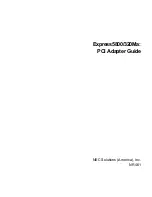
Documentation Number 3PCIO1-0903 Manual
Chapter 6
47
B&B Electronics Mfg Co – 707 Dayton Rd - PO Box 1040 - Ottawa IL 61350 - Ph 815-433-5100 - Fax 815-433-5104
B&B Electronics Ltd – Westlink Comm. Pk. – Oranmore, Galway, Ireland – Ph +353 91-792444 – Fax +353 91-792445
The RS-485 mode is set using 3 jumpers, and by selecting the
RS-
485 Mode
for
DTR Operation
on the com Port.
RS-485 Network Biasing
In a RS-485 network, the transmitter tri-states to a high impedance
state. Unlike RS-422 where the transmitter holds the TD(B) line high
and the TD(A) line low (Mark state) when not transmitting data.
To establish and maintain the Mark state for all RS-485 receivers,
Biasing is required. Biasing maintains a positive voltage difference
from RD(B) relative to RD(A) above the receiver threshold of 200mV
for all devices on that section of the network. If the biasing is not
maintained, the first data bit of a signal may not be detected, and
one or more devices may not respond to commands, or may operate
intermittently.
The RS-485 receiver on the 3PCIO1 is biased with a 4.7 K
Ω
pull-up
resistor on the Receive Data B line and a 4.7 K
Ω
pull-down resistor
on the Receive Data A line. These values are usually adequate for
networks without termination and 31 or fewer nodes. When
termination is used, biasing must be increased, calculated according
to the termination value and number of nodes. Through hole pads
are provided for adding smaller value pull-up and pull-down
resistors.
Port Bias: (Low: R2/14, Hi: R3/13) R2 = R3 = 4.7K
Combination of termination and bias must not fall below 54 ohms.
Termination: Not installed. Not required for baud rates 19.2K or
less.
Termination Resistor Location: R15 (R15
≥
120 ohms)










































